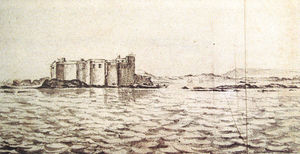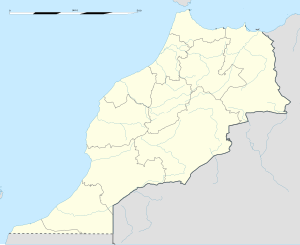Construction (1506)
The Portuguese king Dom Manuel ordered Diogo de Azambuja, the founder of Castello da Mina, to build a castle on a small island, now called "La Petite Ile", in the Moroccan locality of Mogador. [1] The role of the castle was to serve as a relay on their routes along the Moroccan coast, between Safi, where the Portuguese were established since the end of the 15th century, and Agadir, which had just been occupied in 1504. The castle could also easily receive supplies from Madeira. [1]
The building of the fortress was strongly opposed by local Berbers. [1] Other Portuguese captains commanded the castle: Francisco de Miranda and Dom Pedro de Azevedo. On 12 May 1510, the king named Nicolau de Sousa as perpetual commander, but the castle was soon taken over by the local Berbers, and in December 1510 the castle had to be abandoned and the garrison relocated at Safi.
The castle was then occupied sporadically by the local Berbers.
The castle appears in various subsequent documents, as late as 1767 with the map of Théodore Cornut. Soon however the fortifications of Essaouira were updated to become what they are today, and all traces of the Castelo Real have disappeared.

Agadir is a major city in Morocco, on the shore of the Atlantic Ocean near the foot of the Atlas Mountains, just north of the point where the Souss River flows into the ocean, and 509 kilometres (316 mi) south of Casablanca. Agadir is the capital of the Agadir Ida-U-Tanan Prefecture and of the Souss-Massa economic region.

Essaouira, known until the 1960s as Mogador, is a port city in the western Moroccan region of Marakesh-Safi, on the Atlantic coast. It has 77,966 inhabitants as of 2014.

El Jadida is a major port city on the Atlantic coast of Morocco, located 96 kilometres (60 mi) south of the city of Casablanca, in the province of El Jadida and the region of Casablanca-Settat. It has a population of 170,956 as of 2023.
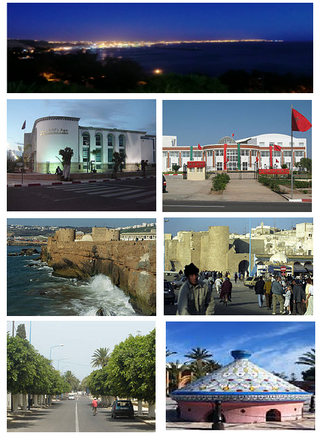
Safi or Asfi is a city in western Morocco on the Atlantic Ocean. It is the capital of Asfi Province. It recorded a population of 308,508 in the 2014 Moroccan census. The city was occupied by the Portuguese Empire from 1488 to 1541, was the center of Morocco's weaving industry, and became a fortaleza of the Portuguese Crown in 1508. Safi is the main fishing port for the country's sardine industry, and also exports phosphates, textiles and ceramics. During the Second World War, Safi was the site of Operation Blackstone, one of the landing sites for Operation Torch.

Diogo de Azambuja or Diego de Azambuja (1432–1518) was a Portuguese noble and explorer.

The Wattasid dynasty was a ruling dynasty of Morocco. Like the Marinid dynasty, its rulers were of Zenata Berber descent. The two families were related, and the Marinids recruited many viziers from the Wattasids. These viziers assumed the powers of the Sultans, seizing control of the Marinid dynasty's realm when the last Marinid, Abu Muhammad Abd al-Haqq, who had massacred many of the Wattasids in 1459, was murdered during a popular revolt in Fez in 1465.
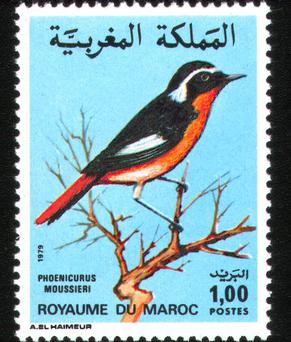
The postal history of Morocco is complex due to the country's political development in the 20th century. Mail was sent via post offices operated by the Sherifian post created by the Sultan, and by the European powers. After Morocco was partitioned into protectorates of France and of Spain in 1912, both European administrations established postal services in their respective zones.

This article is a comprehensive list of all the actual possessions of the Portuguese Empire.

Bourj El Baroud is a ruined watchtower located somewhat south of the mouth of Oued Ksob near Essaouira, Morocco. This structure is located on a broad sandy beach directly across from Phoenician ruins at the southeast tip of the main islet of Iles Purpuraires. This beach is likely the one referred to in Herodotus' account of the Phoenicians' trading with the indigenous peoples of this part of western Morocco. About one kilometre inland is the village of Diabat.
The style of Portuguese sovereign has varied over the years. Currently, there is no Portuguese monarch but there is a pretender: Duarte Pio, Duke of Braganza. He styles himself following some of the ancient traditions of the Portuguese monarchy.
Mehdya, also Mehdia or Mehedya, is a town in Kénitra Province, Rabat-Salé-Kénitra, in north-western Morocco. Previously called al-Ma'mura, it was known as São João da Mamora under 16th century Portuguese occupation, or as La Mamora under 17th century Spanish occupation.

Moroccan–Portuguese conflicts refer to a series of battles between Morocco and Portugal throughout history including Battle of Tangier, Fall of Agadir and other battles and sieges in the Moroccan coast.
The Graciosa fortress was established on the coast of Morocco by the Portuguese in 1489. It was established on a small river island, about three leagues from the sea, at the junction of river Lucus and river el-Mekhazen, a few kilometers inland from modern Larache. The island had been yielded to the Portuguese by Abu Zakariya Muhammad al-Saih al-Mahdi through a treaty following the Portuguese capture of Arzila.

Morocco–Portugal relations cover a period of several centuries largely historic, and to present not particularly substantial relations. Initial contacts started in the 8th century, when Muslim forces invaded most of the territory of the Iberian peninsula. After the Reconquista, Portugal would then expand into Africa, starting with the territory of Morocco, by invading cities and establishing fortified outposts along the Moroccan coast.

The Fall of Agadir refers to the conquest of the city in Morocco by the Saadians against the Portuguese in 1541.
Rahamna, also spelled Rehamna, is a tribe of Arab descent that settled north of the Sahara between the 13th and 15th centuries. Its origins date back to the Yemenite tribe of Banu Ma'qil. Their people descend from one famous common ancestor, namely Rahmoun bin Rizq bin Oudi bin Hassan. The Rehamna, according to Professor Abdul Rahim al-Otri, is one of the Arab tribes that came to Morocco from the Arabian Peninsula through Egypt and Libya, then to Mauritania and Morocco, before settling in the Marrakesh-Al Haouz Region. This cross-country migration gave the tribe a mixture of tribal origins and affiliations and created several clans composed of Arab, Berber (Amazigh) and African components. The tribe, however, is divided into two main groups: the Arabs, and the “Saharans”, which are further divided by smaller groups.
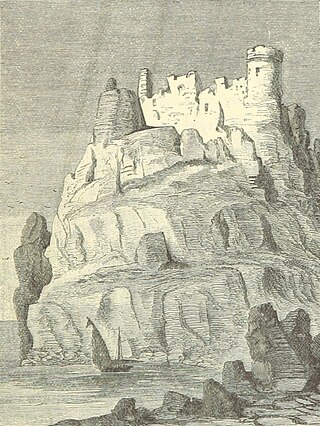
The European enclaves in North Africa were towns, fortifications and trading posts on the Mediterranean and Atlantic coasts of western North Africa, obtained by various European powers in the period before they had the military capacity to occupy the interior. The earliest of these were established in the 11th century CE by the Italian Kingdom of Sicily and Maritime republics; Spain and Portugal were the main European powers involved; both France and, briefly, England also had a presence. Most of these enclaves had been evacuated by the late 18th century, and today only the Spanish possessions of Ceuta, Melilla, and the Plazas de soberanía remain.
The Fort Santiago da Barra de Viana do Castelo also referred to as Castle Santiago da Barra and Castle São Tiago Maior da Barra is located in the parish of Santa Maria Maior, Monserrate, and Meadela, in the city of Viana do Castelo in Portugal.

The 1562 Siege of Mazagan, also known as the Great Siege of Mazagan was an armed engagement that took place in the modern city of El Jadida, then known as Mazagan, between Portuguese forces and those of the Saadi dynasty, which had unified Morocco a few years prior.
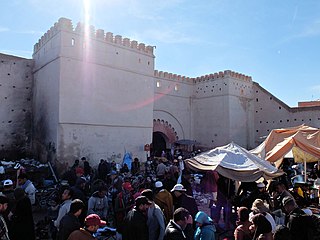
The Raid of Marrakech took place in 1515, when the Portuguese governor of Safi Nuno Fernandes de Ataíde led a raid that penetrated as far as Marrakech in hopes of forcing its Hintata ruler to accept Portuguese suzerainty, the attack, however, failed.
